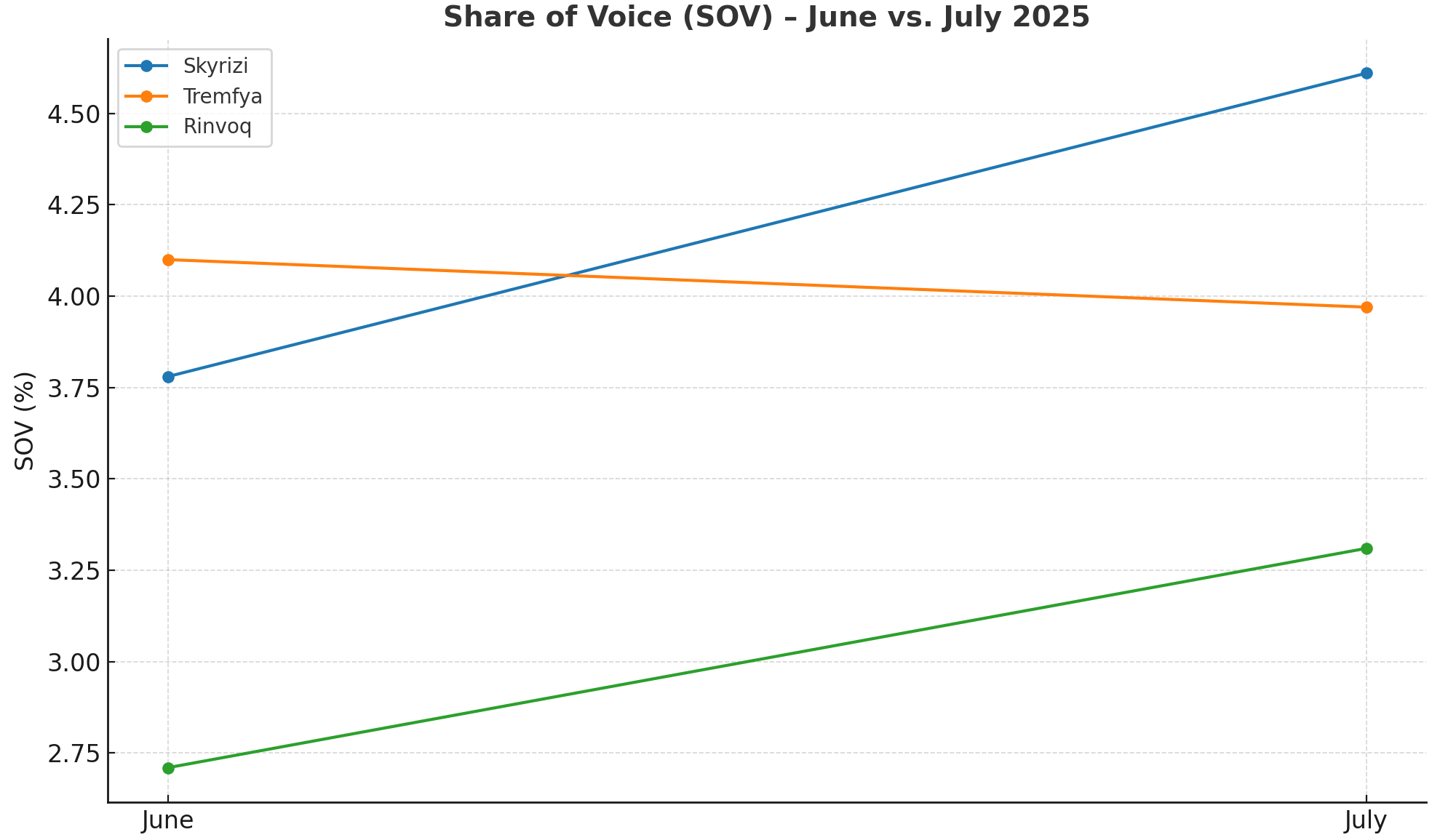Skyrizi Tops July’s Pharma Rankings — and What It Means for Omnichannel Engagement"
In July 2025, pharma campaigns didn’t just grab attention — they sparked full-funnel engagement. AbbVie’s Skyrizi took the No. 1 spot with a 22% SOV surge, but the real story is how leading brands are turning TV reach into omnichannel impact — from news broadcasts to digital retargeting and patient engagement. See the rankings, spend trends, and BioNixus insights on connecting impressions to conversions.
MARKET RESEARCH
BioNixus
8/8/20253 min read


Pharma Digital Leaders in July: Skyrizi Secures Top Spot in USA
In July 2025, pharma brands poured millions into TV ads — but the most successful campaigns didn’t stop there. The top performers used TV as the spark in a wider omnichannel fire, driving engagement across digital, HCP portals, and patient communities
AbbVie’s Skyrizi emerged as the top pharmaceutical brand on U.S. television in July, dethroning June’s leader, Tremfya, and demonstrating the power of strategic ad spend during high-engagement programming.
The psoriasis treatment recorded 2.5 billion TV impressions, capturing a 4.61% share of voice (SOV). This marked a 22% jump in SOV from June to July, fueled by a 14.5% increase in ad spend to $34.7 million and an 8.7% boost in impressions.
July 2025 Top 5 Pharma TV Advertisers
RankBrandCompanySOVImpressions (Billion)TV Ad Spend ($M)1SkyriziAbbVie4.61%2.534.72TremfyaJohnson & Johnson3.97%2.121.63RinvoqAbbVie3.31%1.825.54AdvilHaleon2.99%1.65.15DupixentSanofi/Regeneron2.91%1.613.6
Notable Brand Movements
Tremfya slipped to No. 2 with $21.6M in TV spend, securing 2.1B impressions.
Rinvoq jumped from fifth to third place despite reducing spend from $28M in June to $25.5M in July — a signal of improved efficiency in media buys.
Advil dropped from third to fourth, reducing spend by nearly $3M to $5.1M.
Dupixent re-entered the top five with 1.6B impressions at a steady $13.6M spend.
Networks and Programming Driving Results
The top TV networks for pharma advertisers in July were ABC, CBS, and NBC, with ABC World News Tonight With David Muir remaining the single most impactful program for reach.
Interestingly, news programming proved to be a significant driver of impressions:
CNN pharma ad impressions rose 76% year-over-year in July.
NewsNation was up 52%.
MSNBC increased 36%.
Fox News saw a modest 1% gain.
“CNN’s pharma TV ad impressions grew by 76% year over year in July, showcasing once again how effective news shows are as a reach vehicle for that industry — especially during the summer months when it becomes TV’s tentpole programming,” said Scott Swanson, SVP of Marketing at iSpot.
From TV to Omnichannel: Turning Reach into Measurable Impact
While July’s numbers show where pharma brands spent their TV budgets, the real competitive edge comes from how those impressions are activated across the full customer journey.
Here’s how top pharma advertisers are using TV as the launchpad for omnichannel success:
TV as the Awareness Catalyst
National TV, especially news programming, delivers unmatched reach and trust — two critical factors in healthcare advertising.
High-SOV placements like Skyrizi’s July push create a halo effect, making subsequent digital ads more recognizable and effective.
Digital Retargeting to Sustain Recall
Programmatic platforms, social ads (LinkedIn, Facebook, Instagram), and YouTube pre-roll are used to re-engage audiences exposed to TV spots.
Messaging here is often personalized — for example, showing different benefits to HCPs versus patients.
CRM and HCP Portals to Drive Action
TV prompts interest, but email marketing, gated HCP portals, and webinar invites convert curiosity into engagement.
For prescribers, linking the TV campaign to medical education content increases prescribing comfort and confidence.
Patient Support Programs to Build Loyalty
Once a patient starts therapy, omnichannel continuity is key. Follow-up via SMS, app notifications, and patient education videos reinforces adherence.
This turns the initial TV spend into long-term treatment stickiness.
Closed-Loop Measurement
By integrating TV exposure data with CRM and prescription tracking, brands can measure not just reach, but actual ROI on patient starts and retention.
The leaders are connecting iSpot TV data with Veeva CRM, IQVIA prescribing trends, and social engagement metrics for a full picture.
BioNixus Insight: Why This Matters for Pharma Marketers
From a market research perspective, the July data reinforces several strategic points for pharma advertisers:
Strategic Spend Timing Pays Off – Skyrizi’s coordinated increase in spend and SOV shows that well-timed investment can quickly shift competitive rankings.
News Programming Is a High-ROI Channel – Pharma brands continue to see strong performance during news broadcasts, particularly in summer when other prime-time content is sparse.
Efficiency Over Volume – Rinvoq’s ability to hold impressions while cutting spend highlights the importance of optimizing media buys, not just increasing budgets.
Brand Rotation at the Top – With multiple brands trading positions month to month, competitive monitoring is crucial for sustaining leadership.
At BioNixus, we track these Brand trends in real time to help pharma and healthcare companies make smarter marketing and media investments, optimize channel mix, and benchmark against competitors. Understanding where — and when — to allocate budget spend can mean the difference between market leadership and lost share.

